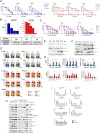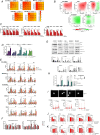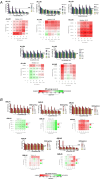Exploring the role of PARP1 inhibition in enhancing antibody-drug conjugate therapy for acute leukemias: insights from DNA damage response pathway interactions
- PMID: 39587643
- PMCID: PMC11590640
- DOI: 10.1186/s12967-024-05838-9
Exploring the role of PARP1 inhibition in enhancing antibody-drug conjugate therapy for acute leukemias: insights from DNA damage response pathway interactions
Abstract
Background: The introduction of antibody-drug conjugates represents a significant advancement in targeted therapy of acute myeloid leukemia (AML) and acute lymphoblastic leukemia (ALL). Our study aims to investigate the role of the DNA damage response pathway and the impact of PARP1 inhibition, utilizing talazoparib, on the response of AML and ALL cells to Gemtuzumab ozogamicin (GO) and Inotuzumab ozogamicin (INO), respectively.
Methods: AML and ALL cells were treated with GO, INO and γ-calicheamicin in order to induce severe DNA damage and activate the G2/M cell-cycle checkpoint in a dose- and time-dependent manner. The efficacy of PARP1 inhibitors and, in particular, talazoparib in enhancing INO or GO against ALL or AML cells was assessed through measurements of cell viability, cell death, cell cycle progression, DNA damage repair, accumulation of mitotic DNA damage and inhibition of clonogenic capacity.
Results: We observed that both ALL and AML cell lines activate the G2/M cell-cycle checkpoint in response to γ-calicheamicin-induced DNA damage, highlighting a shared cellular response mechanism. Talazoparib significantly enhanced the efficacy of INO against ALL cell lines, resulting in reduced cell viability, increased cell death, G2/M cell-cycle checkpoint override, accumulation of mitotic DNA damage and inhibition of clonogenic capacity. Strong synergism was observed in primary ALL cells treated with the combination. In contrast, AML cells exhibited a heterogeneous response to talazoparib in combination with GO. Our findings suggest a potential link between the differential responses of ALL and AML cells to the drug combinations and the ability of talazoparibto override G2/M cell-cycle arrest induced by antibody-drug conjugates.
Conclusion: PARP1 emerges as a key player in the response of ALL cells to INO and represents a promising target for therapeutic intervention in this leukemia setting. Our study sheds light on the intricate interplay between the DNA damage response pathway, PARP1 inhibition, and response of γ-calicheamicin-induced DNA damages in AML and ALL. These findings underscore the importance of targeted therapeutic strategies and pave the way for future research aimed at optimizing leukemia treatment approaches.
Keywords: Acute lymphoblastic leukemia (ALL); Acute myeloid leukemia (AML); Antibody–drug conjugates; DNA damage response pathway; PARP1 inhibition.
© 2024. The Author(s).
Conflict of interest statement
Declarations. Competing interests: GM has competing interests with Novartis, BMS, Roche, Pfizer, ARIAD, MSD.
Figures





References
-
- Walter RB. Brief overview of antibody–drug conjugate therapy for acute leukemia. Expert Opin Biol Ther. 2021. 10.1080/14712598.2020.1817373. - PubMed
-
- Kantarjian HM, DeAngelo DJ, Stelljes M, Liedtke M, Stock W, Gökbuget N, et al. Inotuzumab ozogamicin versus standard of care in relapsed or refractory acute lymphoblastic leukemia: final report and long-term survival follow-up from the randomized, phase 3 INO-VATE study. Cancer. 2019. 10.1002/cncr.32116. - PMC - PubMed
-
- Jabbour E, Paul S, Kantarjian H. The clinical development of antibody–drug conjugates—lessons from leukaemia. Nat Rev Clin Oncol. 2021;18:418–33. - PubMed
-
- Gottardi M, Sperotto A, Di Rorà AGL, Padella A, Cangini D, Giannini MB, et al. Gemtuzumab ozogamicin in acute myeloid leukemia: PAST, present and future. Minerva Med. 2020;111:395–410. - PubMed
-
- Khongorzul P, Ling CJ, Khan FU, Ihsan AU, Zhang J. Antibody-drug conjugates: a comprehensive review. Mol Cancer Res. 2020;18:3–19. - PubMed
MeSH terms
Substances
Grants and funding
LinkOut - more resources
Full Text Sources
Medical
Miscellaneous

